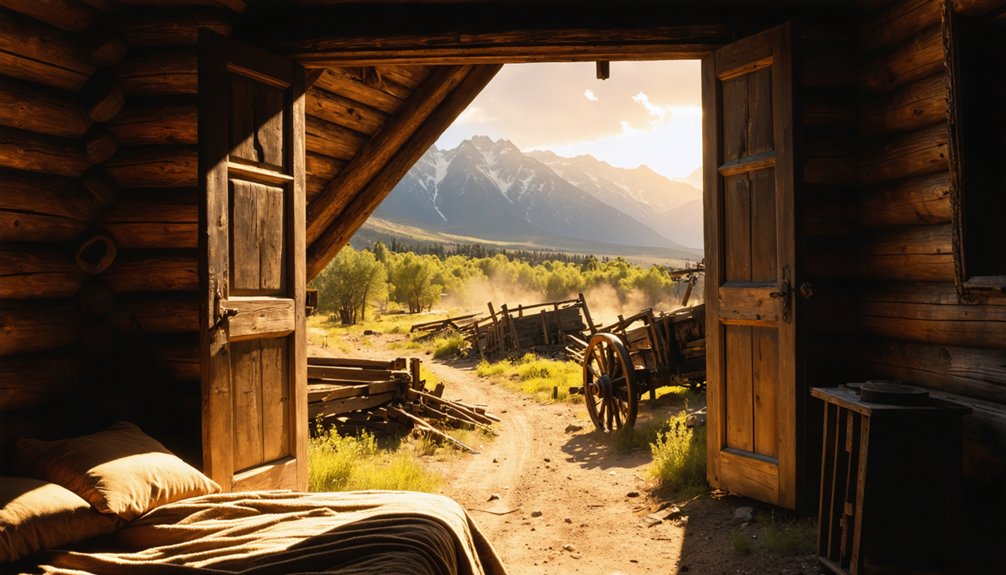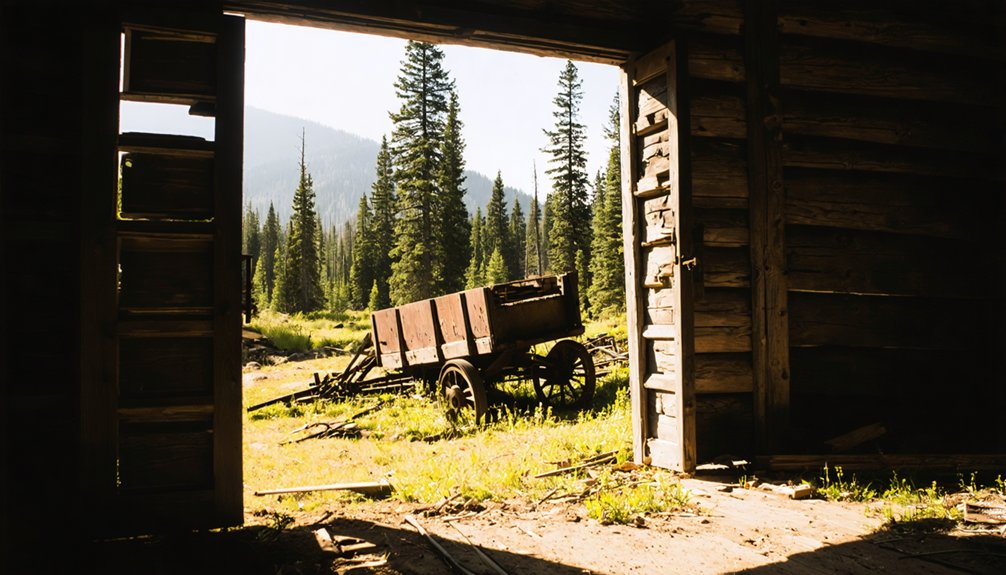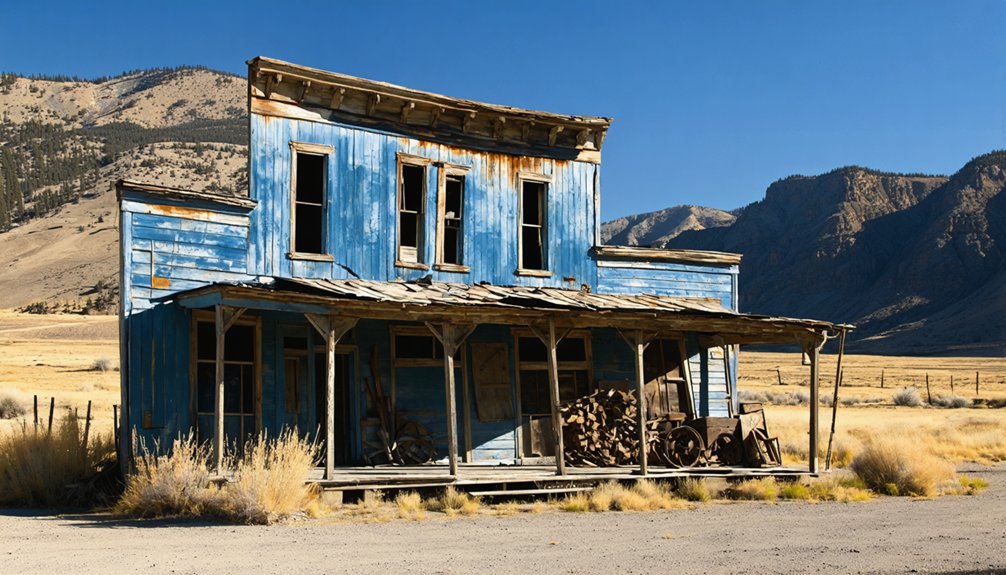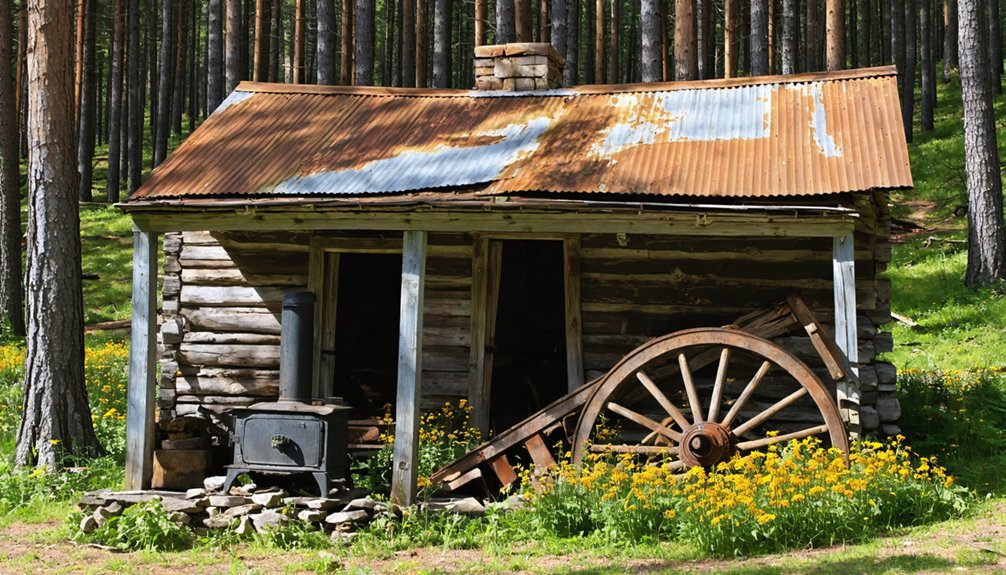You’ll discover Golden Age Camp nestled in Idaho’s rugged terrain, where 19th-century mining operations once transformed the landscape into a bustling frontier settlement. Between 1870-1885, the camp thrived on gold, silver, and lead extraction, with over $140,000 invested in infrastructure. Life centered around simple cabins, the general store, and a twenty-stamp mill employing 150 men. Today’s ghost town reveals fascinating stories of resilience, wealth, and eventual abandonment in America’s mining era.
Key Takeaways
- Golden Age Camp emerged during Idaho’s late 19th-century mining boom, thriving between 1870-1885 as a significant silver and lead mining community.
- The camp featured essential structures including miners’ cabins, a general store, saloons, and Idaho’s first newspaper operation.
- Mining operations employed 150 men at its peak, with some ore zones yielding valuable deposits worth $30-90 per ton.
- The community faced severe challenges including harsh winters, isolation, high living costs, and dangerous working conditions.
- The camp’s decline occurred as gold deposits depleted, though preservation efforts now protect its mining heritage and historic structures.
The Birth of a Mining Settlement
While Idaho’s early mining settlements emerged as modest camps like Miller Camp and Larson Diggins in 1863, Golden Age Camp‘s story began during a significant period of railroad expansion in the late 19th century.
The settlement origins trace back to the region’s boom era, when mining techniques were rapidly evolving and external investment from Pittsburgh and London fueled growth throughout Idaho’s mineral-rich territories.
Lead and silver mining dominated the region’s mineral production by the 1880s, transforming the economic landscape of Idaho’s mining districts.
You’ll find that Golden Age Camp’s establishment followed the typical pattern of boomtown creation, spurred by the promise of wealth beneath the rugged terrain. Mining activity in the region surged after antimony was declared critical for the war effort by the U.S. government.
Like many settlements in the Big Lost River Valley, the camp required substantial infrastructure investment, including costly wagon roads that often exceeded $20,000.
The railroad’s presence proved essential, providing easier access to heavy equipment and offering critical connections to distant markets.
Life in Golden Age’s Heyday
Although Golden Age Camp began as a modest mining settlement, it quickly transformed into a vibrant community during its peak years between 1870-1885.
You’d have found yourself among a diverse mix of settlers living in simple cabins, gathering at the general store for supplies, or sharing stories at one of the town’s bustling saloons.
Camp traditions emerged as residents established social gatherings at the community center, celebrated holidays with parades, and joined organizations like the Masonic Lodge.
While life wasn’t always easy – with threats from disease, mining accidents, and harsh Idaho winters – the town maintained a strong social fabric.
Children attended the local school, while craftsmen, merchants, and small-scale farmers kept the economy diverse beyond just mining activities.
Like other towns in the territory, the community benefited from having Idaho’s first newspaper which kept residents informed of local happenings.
The town’s primary focus on gold and silver extraction mirrored the economic drivers of other successful mining communities across Idaho.
Mining Operations and Mineral Wealth
The rich mineral deposits of Golden Age Camp lay within an intricate network of quartz veins and lode deposits, formed by ancient Cretaceous-age intrusions into the region’s metamorphic and granitic rocks.
Golden Age Camp’s treasures were nestled in complex quartz veins, born from ancient intrusions into metamorphic bedrock.
You’d find these mineralized veins following northeast-southwest trends, stretching up to four miles long and reaching widths of 100-300 feet.
Mineral extraction relied heavily on underground tunnels and shafts, with exploratory passages extending 500 feet to reach productive zones. Like many mining operations in Silver Valley’s districts, the camp faced ongoing challenges from natural disasters but maintained steady production.
For ore processing, the camp’s twenty-stamp mill employed 150 men during the 1880s. The operation yielded impressive returns, with some zones producing ore worth $30 to $90 per ton.
Daily Challenges of Camp Residents
You’d find daily survival at Golden Age Camp heavily dependent on unreliable supply chains, with wagon deliveries often delayed by harsh weather and treacherous mountain roads.
The camp’s isolation meant you couldn’t count on regular shipments of fresh food and essential supplies, forcing you to carefully ration provisions during winter months. Like the residents of Leesburg who relied on cooperative community efforts, neighbors had to share resources to survive the harsh conditions.
Your safety was constantly at risk from both environmental hazards and human threats, as the camp’s remote location attracted lawless elements while leaving you vulnerable to illness and injury without proper medical care. The wild atmosphere resembled early Idaho City, where drifters and thieves mixed with the mining population.
Supply Chain Struggles
Living in Idaho’s Golden Age Camp meant facing daily struggles with unreliable supply chains, as residents grappled with the harsh realities of their remote mountain location.
Supply logistics posed constant challenges, with transportation methods limited to pack trains and seasonal river routes. You’d find yourself at the mercy of weather conditions and primitive infrastructure, making access to essential goods uncertain. The discovery of gold by Pritchard in 1882 initially drew thousands of hopeful miners despite the supply difficulties.
Key supply chain challenges you’d face:
- Basic necessities often cost three to four times more than in urban areas due to difficult transportation routes.
- Winter months could leave you completely cut off from supply routes for weeks at a time.
- You’d need to rely heavily on community cooperation and bartering systems when traditional supply chains failed.
These hardships shaped daily life and required remarkable resilience from camp residents, who’d to constantly adapt to survive. The State Historical Society maintains detailed records of these ghost towns, preserving the stories of their challenging existence.
Camp Safety Issues
Beyond supply chain difficulties, daily survival at Golden Age Camp meant confronting numerous safety hazards that tested residents’ resilience.
You’d face immediate threats from wildlife encounters, requiring constant vigilance when venturing outside camp boundaries. Maintaining campfire safety proved vital, as wooden structures and limited emergency services made fires particularly dangerous. Bar fights and murders occurred frequently, creating an atmosphere of constant danger.
The camp’s remote location left you vulnerable to nature’s fury, from harsh winter storms to spring flooding.
You’d need to navigate poorly constructed buildings, unstable mining tunnels, and contaminated water sources. The lack of proper medical facilities meant even minor injuries could become life-threatening.
Basic law enforcement didn’t exist, forcing you to handle disputes through informal community justice, while mining accidents remained a constant worry due to minimal safety regulations.
Economic Rise and Impact

When gold was discovered in the Boise Basin in 1862, Idaho City’s economy exploded into a thriving frontier powerhouse. The population surged to 6,000 by 1863, making it the territory’s largest settlement.
You’d find stamp mills producing up to $1,000 in gold daily, while mining companies poured over $140,000 into infrastructure development.
The economic sustainability of the region was strengthened by:
- Chinese immigrants’ labor contributions through their businesses and mining work
- Over 60 skilled laborers developing essential mining infrastructure
- A diverse commercial landscape of saloons, stores, and blacksmith shops
Despite challenges like supply shortages and sky-high prices, the boom created lasting economic impacts.
Even after gold production declined, Chinese residents helped stabilize the local economy, setting the foundation for today’s heritage tourism industry.
The Community Spirit
The social fabric of Golden Age Camp emerged from its economic foundations, weaving together a complex tapestry of prospectors, merchants, and laborers.
You’d find a raw, unvarnished community where social networks formed through necessity rather than choice. Daily life centered around mining claims, saloons, and basic commerce, with community bonds forged in the harsh realities of frontier existence.
You wouldn’t find formal institutions or organized support systems here. Instead, miners relied on informal mutual aid, banding together during crises and sharing resources to survive.
While violence and lawlessness were common, residents developed their own ways of maintaining order through vigilante justice and informal dispute resolution.
These social networks, though temporary, reflected the rugged individualism and interdependence that defined life in this Idaho mining camp.
Environmental Legacy

Mining operations at Golden Age Camp left an indelible environmental scar that persists long after its abandonment.
You’ll find the historical pollution from mining activities continues to impact the surrounding ecosystem, particularly regarding water and soil quality. Like many Idaho mining sites, Golden Age Camp’s legacy includes heavy metal contamination that affects the watershed.
- Elevated levels of arsenic and other heavy metals remain in the soil, posing ongoing challenges for natural restoration.
- Waste rock deposits and tailings continue to influence local groundwater quality.
- The surrounding landscape bears permanent alterations from open-pit mining practices.
Today, you can witness the environmental impacts firsthand, as nature slowly reclaims the disturbed terrain.
The site serves as a stark reminder of mining’s lasting effects on Idaho’s pristine wilderness.
The Path to Abandonment
Despite initial prosperity from rich gold deposits in the 1880s, Golden Age Camp‘s path to abandonment followed a familiar pattern seen across Idaho’s mining communities.
You’ll find that the community decline accelerated as easily accessible gold deposits became depleted, and attempts at resource management through hydraulic and dragline mining in the 1920s-30s couldn’t sustain long-term operations.
The camp’s isolation and harsh winters made life increasingly difficult for miners, while inadequate infrastructure complicated supply routes.
When gold prices fluctuated and better opportunities emerged elsewhere, the transient population began to drift away.
Without a diversified economic foundation beyond mining, Golden Age Camp couldn’t maintain its community as the mines’ productivity waned.
The final blow came when modern mining technology made the remaining deposits unprofitable to extract.
Exploring the Ghost Town Today

Venturing into Golden Age Camp today requires careful planning and a sturdy vehicle, as this remote Idaho County ghost town remains accessible only by rough terrain suited for high-clearance transportation.
You’ll find yourself surrounded by scattered ruins and mining remnants that tell the story of Idaho’s mining heritage.
- Keep safety in mind as you explore – unstable structures and open mine shafts pose hazards, and emergency services are far away.
- Document historical artifacts through photography rather than collecting them, preserving the site’s authenticity for future visitors.
- Time your exploration during warmer months, as winter snow can make the area inaccessible.
As you navigate the overgrown trails between collapsed cabins and rusted mining equipment, you’ll experience an authentic piece of early 20th-century mining history untouched by modern development.
Preserving Idaho’s Mining Heritage
While Idaho’s mining past reflects a complex legacy of both prosperity and environmental challenges, dedicated preservation efforts are helping protect the state’s rich mining heritage for future generations.
Idaho’s historic mining legacy tells a story of both economic growth and environmental costs, preserved today through careful stewardship.
You’ll find organizations like the White Knob Historical Preservation Committee working to save historic structures, including the Shay railroad trestle and tramway towers. Through heritage preservation partnerships with the Idaho Heritage Trust, National Park Service, and U.S. Forest Service, these landmarks receive essential support and protection.
Local volunteers play an important role in mining restoration projects, while groups like Earthworks and the Idaho Conservation League advocate for responsible practices.
You can explore this history through improved signage at sites like the Mackay Mine Hill Tour, where preservation efforts balance celebrating mining’s cultural significance while addressing its environmental impact.
Frequently Asked Questions
Are There Any Documented Accidents or Deaths at Golden Age Mine?
You won’t find documented accidents or deaths at Golden Age Mine in available accident reports. Despite Idaho’s strict mining safety regulations, records don’t show specific incidents from this particular operation.
What Happened to the Mining Equipment After the Camp’s Abandonment?
Like many secrets lost to time, you’ll find the mining equipment’s fate isn’t documented. After the ghost town’s abandonment, the equipment was likely salvaged or left to rust away.
Were There Any Famous Visitors to Golden Age Camp?
You won’t find any famous visitors or notable figures documented at this small mining camp. Historical records don’t show any celebrities or dignitaries making their way to this modest operation.
Did Native American Tribes Have Any Interactions With the Mining Camp?
By 1860, 100% of native presence had ceased at the camp site. While Shoshoni and Bannock tribes previously used this area, there’s no record of cultural exchanges or trade relations with miners.
What Specific Mining Techniques and Technologies Were Used at Golden Age?
You’ll find they used hand-drilling, blasting, and stamp milling for hard rock extraction. Unlike nearby areas that used placer mining and hydraulic mining, Golden Age focused strictly on lode mining techniques.
References
- https://www.legendsofamerica.com/idaho-city-idaho/
- https://idaho-forged.com/idahos-ghost-towns-eerie-yet-approachable/
- https://idgenweb.org/archives/history-ghost+towns.html
- https://www.youtube.com/watch?v=9ZbZS1xQ5CI
- https://wheninyourstate.com/idaho/this-peaceful-idaho-ghost-town-was-once-americas-most-dangerous-mining-camp/
- https://en.wikipedia.org/wiki/Florence
- https://caspercollege.cvlcollections.org/items/browse?collection=234&sort_field=Dublin+Core,Title&page=4&sort_dir=a
- https://objects.lib.uidaho.edu/taylorarchive/b4-HistoricalAccounts-008.pdf
- https://perpetuaresources.com/project/stibnite-history/
- https://npshistory.com/publications/crmo/hcs/chap7.htm



